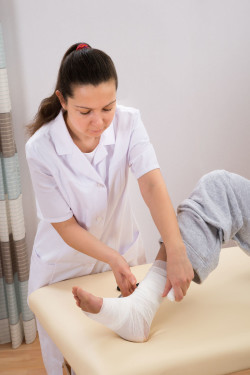 A retrospective review of more than 1,000 patients who suffered an open ankle fracture revealed which factors made a person more likely to suffer a surgical site infection.
A retrospective review of more than 1,000 patients who suffered an open ankle fracture revealed which factors made a person more likely to suffer a surgical site infection.
For the study, researchers reviewed the medical records of 1,003 skeltally mature patients who underwent surgery for an open ankle fracture. They defined an infection as a combination of superficial or deep purulence (pus discharge) and wound dehiscene (sutures rupture). After examining the data, researchers uncovered:
- The incidence of site purulence was 12 percent, and that climbed to 17 percent when accounting for wound dehiscence.
- Being male, having diabetes, taking immunosuppressant medications and smoking all increased a person’s likelihood of developing a surgical site infection.
“Male gender, diabetes, immunosuppressant medications and smoking were associated with growth purulence,” said Margaret Cooke, MD, who presented the findings at the Orthopaedic Trauma Association Annual Meeting. “These same factors, along with Gustilo grade, were associated with any infection.”
Additionally, researchers discovered that certain tested factors did not increase a person’s likelihood of developing an infection after open ankle fracture surgery. Body-mass index, dislocation, Orthopedic Trauma Association classification and antibiotics did not increase infection risk.
Not all factors that increase a person’s risk of surgical site infection are controllable, but researchers say surgeons also play a role in eliminating surgical infection risk. Acts during surgery like having a longer debridement time, a longer time to wound closure or not having a primary site closure also slightly increased infection risk.
“While various patient factors predispose patients to infection, there are some surgeon factors that we may have control over. In particular, time to closure had a clear effect on infection. Finally, infection in this population led to other complications of malunion, nonunion and loss of reduction,” said Cooke.
Dr. Silverman comments
As surgeons, we have an onus to do everything we can to help reduce surgical site infections. Hopefully the patient is living a healthy lifestyle to reduce their likelihood of diabetes and they aren’t a smoker or on immunosuppressants, and although we can’t do anything about their gender, once they are on the operating table, it’s the surgeon’s job to reduce the likelihood of infection.
Knowing what increases the risk of an infection from a surgical standpoint will go a long way in helping reduce infections. I commend these researchers for their work, and hope we see some follow up studies in the future.